by V. N. Muthukumar and M. V. Ramana
First published on SAWF on October 29, 2001
M. V. Ramana is currently at the Program on Science and Global Security, Princeton University.
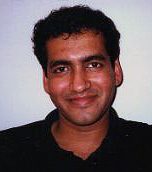
M.V. Ramana
We dedicate this feature to the memory of Papanasam Sivan (Sep 26, 1890 – Oct 1, 1973), one of the great composers of Indian Classical Music. The life of Papanasam Sivan, his contributions to the world of classical music, Tamizh Isai, and film music have all been documented in various sources. However, to our knowledge, his personal reminiscences (written in Tamizh) [1] have not been translated into English. Nor is this slim volume widely available. Therefore, we decided to translate some excerpts of Papanasam Sivan’s “enatu ninaivuk kadal” [2].
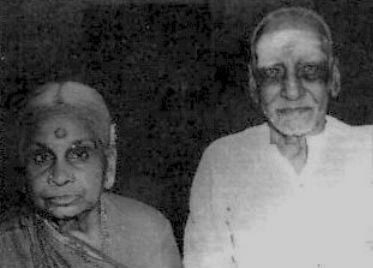
Papanasam Sivan with his wife Lakshmi
The aim of this exercise is twofold. First, there is not much information available in the literature about the (Carnatic) musicians of the early 1900’s, and Sivan’s reminiscences offer some interesting glimpses of this era. Secondly, and perhaps more interestingly, his recollections show the evolution of a great musical mind and the influence of another great musician, Konerirajapuram Vaidyanatha Iyer (1878-1921). In particular, since Sivan did not learn music formally for any significant period of time, his Kritis as well as the manner in which he handles different ragas, offer us a glimpse into the music of Konerirajapuram Vaidyanatha Iyer and other musicians of that era. We offer a sample of Sivan’s Kritis in audio clips, following the translated memoirs.
In the following, we present some excerpts from [2]. We make no attempt to bring the flavor of Sivan’s style of writing into our translation. For those who read Tamizh, we recommend the original for its Tanjavur flavour.
Between 1899 and 1910, Sivan lived with his mother in Tiruvanantapuram (Trivandrum), where he was inspired by the composer Nilakanta Sivan. Nilakanta Sivan passed away in 1903. However, Sivan says he had the fortune of attending Nilakanta Sivan’s bhajans during the years 1902 and 1903.
My primary Guru was “Swarakkudukkai” NUraNi Mahadeva Bhagavatar. He was the son of NUraNi Parameshwara Bhagavatar. Like his father, Mahadeva Bhagavatar was the Asthana VidwAn in the court of Trivandrum. He had a thin voice that could span three octaves. His expertise in singing swaras earned him the title “Swarakkudukkai”. During the months of Aippasi and Panguni, an Utsavam used to take place in the temple of Padmanabhaswamy in Trivandrum. During this festival, the idols of Padmanabha, Narasimha and Krishna were taken around the corridors of the temple, to the accompaniment of the asthana vidwAns singing the kritis of Swati TirunAL. Mahadeva Bhagavatar was a key figure in these proceedings. I vividly recall an occasion where he started the fast paced kriti in Khamas [3], “sArasasama…“. In the third stanza, “prakata pala …“, the musicians started swara prasthara. Each musician sang in turn and the resulting music was inspiring. Though 63 years have lapsed since, the scene and the music are etched in my mind. Some of the musicians in that gathering were Ganapathy Bhagavatar, Ramaswami Bhagavatar, Vishvanatha Bhagavatar and Somayaji Bhagavatar. Mahadeva Bhagavatar’s eldest son who was called Bhairaviccamy gave a brilliant rendition of “ninnu sevinchina…” in Yadhukulakambodi. I learnt music from Mahadeva Bhagavatar for about three months. He taught me the introductory sarali varisais and alankara gitas.
From Sivan’s writings, it is clear that he did not have a traditional musical curriculum. He learnt bits and pieces of music from many people and rues that he did not heed the advice of Krishna Bhagavatar, who told him to go to an accomplished musician for formal training. However, Sivan was more drawn to the music of bhajans and Harikathas.
Rama Navami was celebrated with much enthusiasm in Trivandrum. In the mutt at Pazhavangadi Street, Rama Navami was celebrated for 10 days. Those 10 days were extremely busy days for me. The Harikatha in the mutt began at 9 in the evening and went on till 2 a.m. In those days, my mother had a serious stomach ailment. I worked as a cook and handyman in many places in the area, particularly in Ootuparai, yet another place where Ramanavami was celebrated on a grand scale. During the day, I worked in Ootupurai as a cook. I had to fill the eight water tanks twice, assist in the cooking, and help serve food to the thousands of people who turned up for lunch and dinner. After dinner, I used to run back to listen to the Harikatha. It was here that I first heard ManamElkudi Venkatacala Bhagavatar. He was 75 then, and had a deep and resonant voice. Though his music was mediocre, his commentary on songs such as “cakkani marga…” of Thyagaraja was very erudite. Such was his vidwat that Harikesanallur Muthiah Bhagavatar and Ennaipadam Venkatarama Bhagavatar stood behind him during the Harikatha and offered vocal support for the entire duration of 10 days. ”
“A poet once said that a man must be endowed with the five va’s – vastra, vapus, vAk, vidya and vinaya. Tiruppazhanam Pancapakesa Bhagavatar was an example of this. He was a very handsome man, always wore the best clothes, and had splendid oratory skills. He started out as a narrator of Puranas, and went on to specialize in Harikatha pravacana. He was a rasika and could therefore tailor his recitals to suit the tastes of his audience. He came to Trivandrum in 1906 on the invitation of King Mulam TirunAL. Tanjavur Rao (who was known as Jutka-vaNdi Babu) accompanied him on the Mridangam. I heard him discourse on the story of Chandrahasa for three hours before a huge crowd. The next day, at the residence of the Diwan, he gave a musical discourse on the life of Kabir. Each scene he depicted was like having a movie being played in front of our eyes. Later in my life, when I started doing my bhajans at Tiruvaiyaru, Bhagavatar would always host our group at his doorstep in Tiruppazhanam. He used to celebrate Rama Navami on a grand scale at his home in Kumbakonam. All the vidwans in South India participated in this festival. He was also involved, as an office bearer, in conducting the Thyagaraja Aradhana at Tiruvaiyaru.
If Pancapakesa Bhagavatar could be compared to the dazzling sun, Harikesanallur Muthiah Bhagavatar was the bright full moon in the firmament of Carnatic music. He was a great musician and composer, and was adept at Hindustani music as well. He had a very keen intellect, mellifluous voice and a thorough understanding of sangeeta shAstra. Muthiah Bhagavatar was a devotee of Subrahmanya and therefore reveled in a discourse of “VaLLi KalyANam“. Indeed, he was instrumental for this story gaining a place in the repertoire of the Harikatha vidwans. He was the asthana vidwAn at the court of the Mysore Maharaja for several years and also adorned the court of Travancore. Muthiah Bhagavatar used to celebrate Skanda Shasti for seven days in Harikesanallur. The occasion was typical of Bhagavatar’s life style, lavish and generous. During those seven days, all the prominent vidwans could be found only in Harikesanallur.
In 1910, Sivan returned to Tamizhnadu and stayed with his brother in Papanasam village. It is clear from his writings that Sivan, in his early years, was drawn towards bhajans and Harikathas. In fact, he abhorred classical music as practiced on the concert platform! It is clear from his writings that he started composing songs during this stage of his life. However, he was primarily driven by devotion rather than abstract music. It was only around 1912 that he started listening to “classical” music. This stage of his life marked an important evolution in Sivan’s musical journey. From being a “mere kirtana-driven devotee”, Sivan matured into a classical composer. For this, the world of music owes a debt of gratitude to the great vocalist, Konerirajapuram Vaidyanatha Iyer. The story is best told in Sivan’s words.
In January 1912, KonErirajapuram Vaidyanatha Iyer came to Mannargudi to sing at a wedding. Tirukkodikaval Krishna Iyer accompanied him on the violin and Tanjavur Pakkiri provided the Mridangam accompaniment. During this time, I was totally involved in bhajans and the like. With all the presumptuousness of a 22 year old, I was convinced that music was meant solely for the praise of God and that anything else was a waste of time. So, I never attended any concert. An elderly gentleman, Pazhaiavalam Subba Iyer, persuaded me to accompany him and we went to hear Vaidyanatha Iyer. In those days, I used to look like an exotic creature. I only wore a short dhoti around my waist, and did not have anything other than Vibhuti on my body. We went to the concert and Subba Iyer got us seats near the stage. After about 45 minutes, Iyer started singing Thayagaraja‘s “entuku peddala…” in Sanakarabharanam and proceeded to do neraval on the line “antari nila thadi thadi“. I could not understand a word of it, since it was in Telugu and I could not recognize anything like “Rama”, “Krishna” or “Siva Siva”. I was reminded of Sankara‘s Bhaja Govindam where he rebukes the grammarians and logicians for wasting their times on abstruse sutras, rather than uttering the Lord’s name. I could not tolerate it any longer, turned to Subba Iyer and said, “you may want to listen to this, but not I”, and walked out of the concert in a huff.
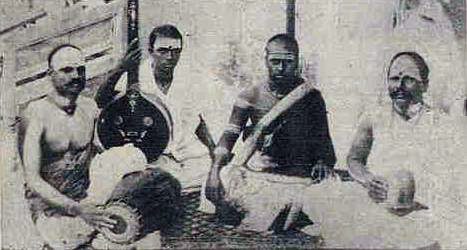
Konerirajapuram Iyer with Pudukkottai D. Pillai on the mridangam
and Manpundiya Pillai on the Kanjira
Three months later, there was another wedding at AlangAdu, near Muthupettai. I attended the wedding in the company of Moonkilkudi Kannusami Iyer (father of T. K. Srinivasa Iyer). On reaching Alangadu, I found out that Vaidyanatha Iyer was scheduled to sing at the wedding, accompanied by Govindaswamy Pillai (violin), Umayalpuram Kothandarama Iyer (mridangam), Pudukkottai Dakshinamurthy Pillai (kanjira) and Aadhichapuram Sitarama Iyer (morsing). Everyone was excited about the concert, but I decided not to attend. So, I left the venue of the wedding shortly before the concert and went to a dilapidated mantap on the outskirts of the village. I sat there for a few hours, and around 8 p.m., returned to the marriage pandal, thinking the concert would have ended by then. As I neared the pandal, I was attracted by the sonorous voice of the vocalist. I could not approach the concert stage, as the hall was extremely crowded. Bhagavthar was proceeding to do neraval in Gopalakrishna Bharathi‘s composition in Kambodi “tiruvadi caranam“. Somehow, I managed to plough through the crowd and went and sat near the dais. I was totally absorbed by the music. This was not music for the ears, rather for the soul. There was absolute silence in the audience and I shed tears of joy. It was a turning point in my life.
Vaidyanatha Iyer seems to have known Sivan, at least by name. Recall that by this time, Sivan had built up a modest reputation in conducting bhajans.
After the concert, Vaidyanatha Iyer got off the stage, came up to me and said, “so, you liked my concert today, didn’t you?” I said, “why can’t you sing such songs in Tamizh?” He smiled and just said, “come to my home”. So, I went to his village and stayed at his place. I stayed there for several months and became part of Iyer’s family. Iyer’s voice was not suitable for imparting vocal training to students. One had to be in his company and absorb his music. However, his music was so powerful that it sufficed just to listen. It had the capacity to make a deep and lingering impact on the student.
The above remark is as much a reflection of Sivan’s keen musical sense as a student, as it is a description of Iyer’s music. All too often, we witness the phenomenon of students imitating their teachers (or their musical heroes) when it is neither appropriate nor desirable.
I must have listened to about 50 concerts of Iyer’s. Only after hearing him, did I realize that music transcends the barriers of language and is universal in appeal. His music was very special. After listening to his concert, his music would play incessantly at the same shruti in one’s mind. His concerts commanded and received total attention from the listener. There would neither be any applause nor the usual punctuation like “bhesh, shabhash” from the listener. In May 1912, I heard a brilliant concert at Kumbakonam. Iyer sang at the Grhapravesam of ANdakkudi Rajagopala Chettiar‘s new house. His accompanists were all veterans; Govindaswamy Pillai on the violin, Venu Chettiar on the mridangam and Mamundia Pillai on the kanjira. There, Iyer sang a marvellous alapana in Begada, followed by the kriti “manasuni nera…“. This was followed by a fast paced “anupama gunambudi…” in AtANA where he did some scintillating swaraprasthara. On the violin, Govindaswami Pillai was stretched to his limit. Normally, Pillai never showed any signs of exertion during a concert. But during that concert, he was drenched in sweat and carried away in appreciation of Iyer’s music. Mamundia Pillai was like a Guru to Iyer. On that day, even he turned to Iyer and said, “BalE, Vaitha. Today, you seem to be a new Vaitha with seemingly boundless manodharma. Sing some more.” The concert lasted for a good 4.5 hours.
The same year, I had the fortune of accompanying Iyer to Harikesanallur for the Skanda Shashti festival organized by Muthiah Bhagavathar. The music I heard there, the scenes I saw still remain in my memory though it happened a good 55 years ago. We had reserved two train compartments from Trichy Junction. Harikesanallur was packed with vidwAns and rasikas from all over. The entire village played host to the visitors. In the world of music, Muthiah Bhagavathar was an Ajatachatru. He had no enemies and was liked and regarded by all. So, it was not a surprise that all the vidwAns turned up at Harikesanallur. On Shashti day, all the vidwAns participated in the unchavrtti. Among the vocalists were Iyer, Kallidaikurichi Vedanta Bhagavatar and among the violinists, Govindaswamy Pillai, Shyamala Iyer. Great percussionists such as Kumbakonam Azhaganambia Pillai, Tanjavur Vaidyanatha Iyer, Pudukkottai Dakshinamurthy Pillai accompanied them. I felt I was in DevalOkA surrounded by divine musicians. That afternoon, Bhootalur Krishnamurthy Sastri played the gOttu vAdyam. He played a very elaborate alApanA of the raga SrI. Till this day, I have not heard anyone handle the raga SrI in such a delectable way. In the evening, Madurai Pushpavanam sang to the accompaniment of Govindaswamy Pillai, Azhaganambi Pillai and Dakshinamurthy Pillai. In those days, Vaidyanatha Iyer and Pushpavanam shared the top spot in vocal music and there was a lot of rivalry between their respective fans. In the purANAs, we never hear of a fight for supremacy between Siva and Vishnu. However, the Saivities and Vaishnavites often fight tooth and nail about the greater God. It was the same way with Vaidyanatha Iyer and Pushpavanam. While they had great respect and admiration for each other’s music, the music world was divided into two large fan clubs, each swearing by their idol.
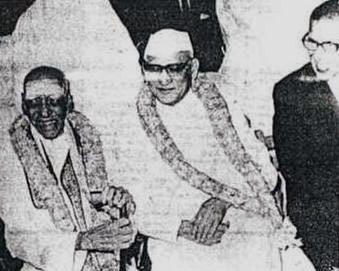
The Music Academy honors itself by bestowing on Sivan
the title Sangita Kalanidhi in December 1971.
Sivan is seen here with the Governor of Tamizh Nadu, K.K. Shah
The next day, Tiruppazhanam Pancapakesa Sastri performed Harikatha at 6 in the evening. Vaidyanatha Iyer’s concert was scheduled for 10:30 in the evening. Thousands of people from adjoining towns and villages had gathered to hear him. Even the rasikas from Kallidaikurichi (who normally rate the music of sage Narada below that of Kallidaikurichi Vedanta Bhagavatar) were present in large numbers. Iyer started with an alApanA in Hamsadhwani, followed by the kriti “raghunAyakA..“. By that time, the mridangam’s sruti slipped. Dakshinamurthy Pillai tried to tune the mridangam back to its original sruti and could only succeed partially. Ten minutes later, the mridangam went off key again and Pillai tried another instrument. After a while, this instrument went off key as well and Pillai, resigned to a bad concert, told Iyer, “carry on”. (Later, we found out that Pillai was unwell that day.) Naturally, the concert never looked like taking off and many vidwAns walked out of the concert pandal. Around midnight, Iyer started alApanA in TODi. Within minutes, the atmosphere became charged with music. I have never heard a TODi like that in my life. It was beyond all imagination. Within minutes, people who had walked out were drawn back into the pandal.
Many vidwans have described Vaidyanatha Iyer’s TODi in superlative terms. Since Iyer inspired Sivan, it is natural that his TODi kritis (numbering about 20) were strongly influenced by Iyer’s TODi. Several musicians who have heard Iyer’s music such as the great Nadaswaram exponent Mannargudi Chinna Pakkiri have made this point.
Once, Iyer sang in Ammangudi. On that day, I had to perform the shrAddhA ceremony for my father. I performed the ceremony in my aunt’s house in Kumbakonam and walked (ran, as a matter of fact) 7 miles to Ammangudi to hear Iyer. The concert had already begun when I arrived and I could not get near the stage. However Iyer saw me and sent someone to bring me to the stage and made me sit with him. During the concert, I noticed two people near the stage who were talking intermittently. I was very annoyed and turned to them and said, “don’t talk”. Iyer then turned to them and said (pointing to me), “he is very intelligent. Listen to this kriti of his”. He then sang my kriti in Kambodi, “sikkal mEviya…” elaborately. Subsequently, he sang Thyagaraja‘s “hari nEnenthu…” in Karnataka Bihag and his imagination ran riot while doing swaraprastArA for the phrase “kalushAtmudai“. After the concert, we went to the house where Iyer was a guest and he was surrounded by a host of vidwAns. The two people whom I had rebuked were also there and they asked Iyer about me. Iyer asked me to sing for them and I sang for a while. Subsequently I was very embarrassed to find out that the two were the great vidwAns, UmaiyaLpuram Swaminatha Iyer and Tiruvidaimaruthur GOttu vAdyam Sakarama Rao.
That night, Iyer and I left for Madras where he had a concert. I took Iyer’s permission and spent a month in Madras. I stayed with the great freedom fighter Subramania Siva. While in Madras, I also made the acquaintance of varakavi Koteeswara Iyer. While in Madras, I wrote a commentary for Jayadeva‘s Ashtapathi and a drama, “Bhakta MArkaNdEyA“. Then, I toured around Tamizh Nadu for a while before returning to Konerirajapuram. A week later, Iyer sang at the wedding of TirukkarugAvUr Pantulu Iyer‘s daughter (Pantulu Iyer was a freedom fighter). Needless to say, the concert was well attended. Kozhumam Zamindar Sundararajan who was in the audience spoke very appreciatively of Iyer’s music. Iyer then interrupted him and said, “so if someone else sings now, you wouldn’t listen, would you?”. Sundararajan replied, “why do you say that? Don’t I know you would only ask a competent person to sing?” Iyer turned to me and asked me to sing for a while. I sang for half an hour. Iyer appreciated my music and asked the patrons who were there to honor me. I was presented with an AngavastrA and Rs. 50. Though I was not destined to get the love and affection of a father, I received it in full measure from my Guru.
The death of Iyer in 1921 was an irreparable loss to the world of music. Three people who followed his bANi in singing rAgA were Trichy Kanakasabhai, Alangadu Krishnamurthy and a Dikshitar in Chidambaram. I have been told by many vidwAns like Musiri Subramania Iyer and Marungapuri Gopalakrishna Iyer that my music bears some semblance to Iyer’s. For this, I count myself fortunate.
Much has been written about Sivan’s Kritis [4]. Here, we shall merely present a few samples of his creations.
A Sivan Sampler
While Sivan kritis are a staple feature in concerts, most of the songs we present below are rarely heard on stage.
We begin with a song that appeared in the Tamizh film, “AshOk KumAr”. Sung by M. K. Thyagaraja Bhagavatar, this song is set to the rAgA KuntalavarAlI. An appropriate choice, since Sivan composed his first kriti unnai tutikka in this rAgA.
When Sivan settled in Madras in 1929, Rukmini Devi Arundale was among the first to recognize his genius. She appointed him as a music teacher in Besant High School, and subsequently at Kalakshetra. Sivan was associated with Kalakshetra from 1934-39, where Rukmini Devi was also one of his students. Perhaps, this sojourn at Kalakshetra inspired Sivan to compose several pada varNams that are now part of standard repertoire in BharatanATyam. The following clip features one such varNam. The rAgA is SriranjanI, and the vocalist, Sivan’s grandson, Ashok Ramani.
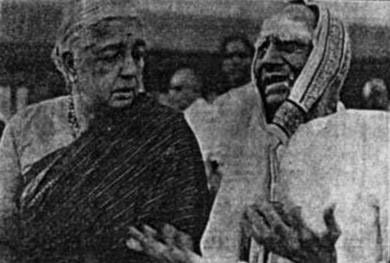
Rukmini Devi Arundale with Papanasam Sivan
Several leading musicians learnt music from Sivan. Here, we listen to S. Rajam speak a few words about his Guru, Papanasam Sivan. As a prelude to Sivan’s kriti in the rAgA NatabhairavI, Rajam also points out why NatabhairavI is not very prevalent. The rAgA uses D1 and N2. The more common rAgAs Kharaharapriya and Bhairavi employ D2 and N2. While delineating NatabhairavI, performers tend to drift towards the D2, N2 combination. In fact, the violinist accompanying S. Rajam in this clip provides a perfect example of this pitfall, during swaraprastArA.
S. Rajam now sings the popular kriti, sri valli.
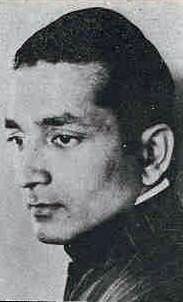
A young S. Rajam
Sivan was deeply committed to Tamizh, Tamizh Isai and the freedom movement. In the next kriti that we present, Sivan pays tribute to another great Tamizh poet and freedom fighter, MahAkavi Subramania Bharati. Sanjay Subrahmanyan sings the kriti, paamaalai, in the rAgA Harikambodi [3], [5]. The phrase Sanjay uses for neraval, tamizh nADu sei tavap payanAi vanthavA, speaks of Tamizh NADu’s fortune in begetting a son such as Bharati. This phrase is equally applicable to Sivan.
Invoking the Goddess of Learning, Trichur V. Ramachandran sings a Sanskrit kriti of Sivan in the rAgA DEvagAndhArI, shArade vINA.
Madurai Mani Iyer popularized several of Sivan’s kritis. Here, he sings AndavanE in the rAgA ShanmukhapriyA.
Sivan will always be remembered for the bhajans he conducted all over Tamizh NADu. By “bhajans” we do not mean the rendition of songs/kIrtanams by a group of people. In these bhajans, people sing invariably alone, offering the best of classical Carnatic music. According to Sivan’s contemporaries, Sivan revelled in the rendering of Viruttams, tEvAram and the kritis of Tyagaraja during these bhajans. Many of Sivan’s kritis were also composed in these bhajans. From 1921, Sivan conducted bhajans in Mylapore, both during the annual festival at the KapAlIswarar temple as well during the month of mArgazhi. The mArgazhi bhajan continues to take place in Mylapore, Chennai. For a description, we refer the reader to the articles by Burma Sankaran [6] and M. V. Ramana [7].
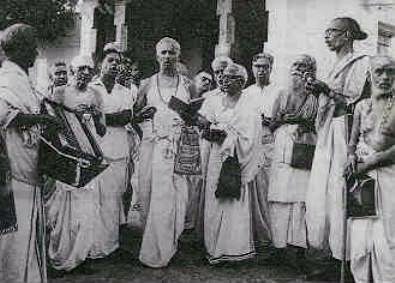
Sivan (second from left) at a street Bhajan in Mylapore, Chennai
In the following clip Sithalapati Balasubramanian talks about the “Sivan bhajanai” as it is known. He also recounts (as told to him by his uncle Mani Iyer, a disciple of Sivan) the story behind the kriti in MaNirangu, kadalil amizhndituvOm. Sometime during the 60’s, Sivan was requested to conduct his bhajan during the temple festival in Trichy. Those were the heydays of the Dravidian movement, spearheaded by E. V. Ramaswami Naicker (EVR). The DK (Dravidar Kazhakam) organized a “pakuttarivu maanAdu” (rationalist convention) to rival the temple festivities. Fearing for the safety of Sivan, the temple trustees suggested he abandon the bhajan (the bhajans are always held on the four streets that surround a temple) and instead, sing inside the temple. Sivan refused saying, “… it is his (EVR’s) duty to speak and mine to sing”. On that day, he composed the kriti in MaNirangu, which describes God as bestowing man with the power of discrimination (in Tamizh, “pakuttarivu” – also the name of the rationalist movement!).
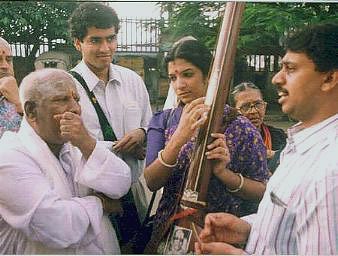
Sivan Bhajanai, December 1995. From left, Sithalapati
Balasubramanian, M. V. Ramana, G. A. Baby and Ashok Ramani
Sivan’s musical life can perhaps be summarized by the word “bhajanai“. So, it is fitting to conclude our feature with a song where he orders his mind to do bhajanai invoking the name of Lord Rama: sri rAma nAma bhajanai sei manamE. The song, describing the mahimA of the RAma nAmA, says “… it is the name that is always on the tongue of the RAmadAsA…” RAmadAsa was also Sivan’s colophon and we leave the listener with Sivan singing this kriti in AtANA. This recording was made two years before he passed away and his disciples Rukmini Ramani (vocal support) and Lalgudi Jayaraman (violin) accompany him.
Acknowledgments
We thank Rajan P. Parrikar for his help in making the audio clips and editing this article. We are indebted to Tiruppugazh Natarajan for opening the wonderful world of Sivan kritis to us. We thank Sumitra Ranganathan for her help with translation.
References
[1] The reminiscences first appeared in the Sunday edition of the Tamizh daily, “Dina MaNi” between January 1968 and July 1968.
[2] “enatu ninaivuk kadal“, by Papanasam Sivan (publ. Rukmini Ramani, 1996, Madras). For an interview with Rukmini Ramani on Papanasam Sivan, see: https://www.sangeetham.com/paps.htm
[4] For a list of Sivan’s kritis, see, for instance, https://www.geocities.com/Athens/Acropolis/1428/
and https://www.papanasamsivan.com
[5] For Sanjay’s Subhramanyan‘s impressions on the Sivan Bhajanai in Madras and Sivan’s compositions, see https://www.sangeetham.com/raaga_appre.htm
[6] https://www.chennaionline.com/musicseason2k/features/margazhi.asp
[7] https://www.geocities.com/CollegePark/5409/season.html See also M. V. Ramana, “Margazhi Bhajanai” in Sangeetham, Vol. 18, 176 (2001).
